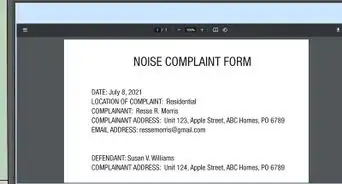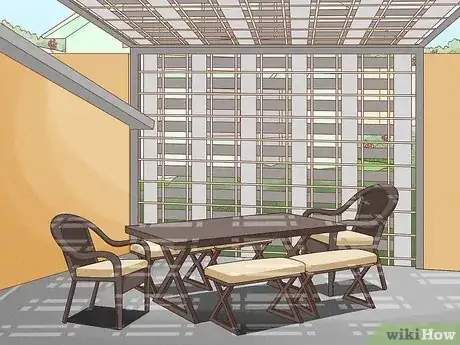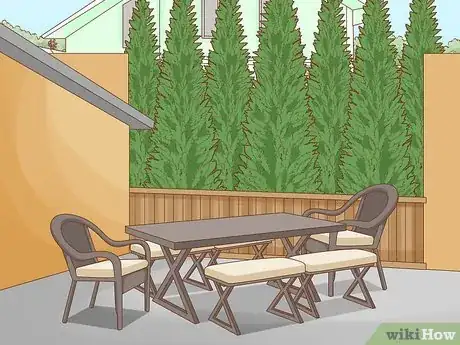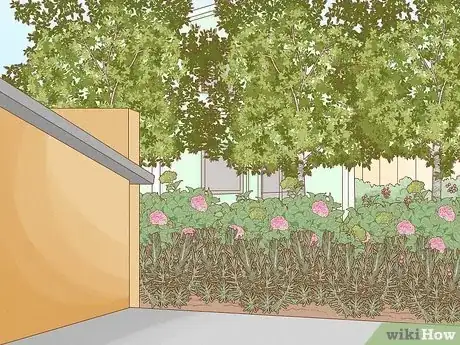This article was co-authored by Grant Wallace and by wikiHow staff writer, Glenn Carreau. Grant Wallace is a Landscaper and Owner of Grantlanta Lawn in Atlanta, Georgia. With over seven years of experience, he specializes in lawn maintenance and landscape installation. In 2012, he earned his BA from the University of West Georgia. Grant has been profiled in Shoutout Atlanta, Canvas Rebel, and Voyage ATL.
There are 11 references cited in this article, which can be found at the bottom of the page.
This article has been viewed 7,683 times.
Worried your neighbor can see into your yard (or home) a little too often? No problem! There are all kinds of simple ways to block out a nosy neighbor's view, even if you’re dealing with a neighbor who can see into your yard from the 2nd floor. Read on for a complete list of quick, easy, and affordable privacy solutions to stop your neighbor from seeing into your yard and home.
Things You Should Know
- Outdoor screens and curtains are easy to install and highly effective at shielding your deck or patio from neighbors year-round.
- Layered plants, trees, extra-large planters, hung plants, and lattice screens with vines also give natural protection for yards and patios.
- Wood and metal fences are simple options that completely block the neighbor's view. Hedge walls also provide coverage of your yard.
Steps
Hang outdoor curtains.
-
Outdoor curtains are inexpensive and easy to install on a patio. Purchase a set of outdoor curtains and hang them with an outdoor curtain rod; most outdoor curtains come with grommets (the small holes with which you hang a curtain), just like indoor curtains. Use the side posts of your deck or patio to hang the curtains. Once set up, they easily block neighbors' views when drawn shut.[1] X Research source
- Curtains are also easy to remove and store when they're not needed.
Attach outdoor screens to your patio.
-
Outdoor screens fully shield you from neighbors and are easily portable. Measure your patio beforehand, so you know how many screens to get. Then, purchase outdoor privacy screens, simply panels of cloth or mesh mounted on metallic stands—so there's no complicated installation! Position them around your patio to create a barrier between you and your neighbors.[2] X Research source
- Because they're so simple in construction, moving the screens when you need to adjust their coverage (or store them temporarily) takes little effort.
Use lattice screens.
-
Lattice screens provide a picturesque and effective barrier. They're also extremely cost-effective! Purchase wooden lattice screens and have them installed like a fence in your yard, blocking off the area you want more to protect from your neighbor's view. For extra privacy, plant vines in front of the lattice screens so they can climb up the lattice over time.[3] X Research source
- Alternatively, you could set up a trellis. They're smaller than fences but perfect for protecting a deck or patio and can also support vines for privacy.
- Ideal vines include wisteria, morning glory, honeysuckle, trumpet vines, and ivy.
Install an overhead shade.
-
Overhead shades stop neighbors from looking down onto your deck. Buy an overhead shade and hang it so that it covers your deck, affixing its corners to the side of your house and two of the deck's posts. Also called a "sun shade," these large tarps give you overhead protection, so even people on the 2nd story of their home can't see your deck.[4] X Research source
- Overhead shades come in various shapes, sizes, and colors. Pick one you like, and measure your deck to ensure it fits the area.
Hang plants to make a vertical garden.
-
Hanging plants is a subtle way to block the view and save space. On a patio, porch, or covered deck, hang plant baskets at staggered levels from the ceiling to create a DIY privacy screen. Hang the lowest baskets close to eye level and other baskets slightly higher to fill in the gaps. When staggered, the hanging plant baskets cover more space and provide more coverage![5] X Research source
- The number of baskets you'll need depends on the space you want to cover. Measure the area first, then calculate how many baskets you need based on the plants' size.
- Water your plant baskets regularly. In the fall, trim the flowers or replace annual blooms with chilly-weather plants like chrysanthemums.
Set up extra-large planters.
-
Planters are large enough to give you privacy, and the plants look good. If you have the space for them, invest in large planters—which can vary in size but are usually at least 2 feet (0.61 m) wide. Arrange them in a row between your house and your neighbor's, and fill the planters with tall flowers and shrubs suitable for the environment.[6] X Research source
- Tall plants that could grow in a planter include arborvitae, boxwood, elephant ear, hibiscus, yucca, hydrangea, and agave.
- Though planters are easy to find and purchase, you can also make a planter box at home.
- Trim the flowers regularly as they grow to ensure they don't hang over onto your neighbor's property, as they might get upset by that.
Set up a row of bamboo.
-
Bamboo grows tall enough to block your neighbor's view of your yard. If you like the look of bamboo better than a traditional hedge, consider planting rows of bamboo around your yard to create a privacy shield. Pick a species of bamboo that can thrive in your area and plant a bamboo fence in your yard, spacing each plant in the row roughly 3 feet (0.91 m) apart.[7] X Research source
- Prune your bamboo wall back periodically to help it grow thicker and ensure it gets about 1 inch (2.5 cm) of water each week. Bamboo can grow in many conditions but prefers full sunlight if possible!
Plant trees or clusters of shrubs.
-
Layered plantings provide privacy, texture, and color to your yard. Rather than using only hedges, plant evergreen and deciduous trees, shrubs, and perennial plants. Stagger larger trees in the background and fill the foreground with mid-size or small plants. This creates a layered, colorful look in your yard—and the trees provide coverage for 2nd-story windows, plus shade on sunny days.[8] X Research source
- Birch, maple, and oak are all great deciduous shade trees, and popular evergreen trees include pine, fir, and cypress.
- Ideal fast-growing shrubs are lilac, dogwood, forsythia, arborvitae, and laurel. Popular perennials (which bloom yearly) include daylilies, lupines, hydrangeas, allium, coneflowers, and lavender.
Grow hedges around your house.
-
Hedges provide a more natural method of walling off your yard or home. Pick evergreen hedge shrubs that are well-suited for your environment and grow them like a wall around the property. Some grow even taller than 6 feet (1.8 m), blocking off your yard and your house's 1st-floor windows. Plus, the greenery is aesthetically pleasing compared to many walls and fences![9] X Research source
- Hawthorn, laurel, camellia, European beech, and arborvitae are all evergreen plants that make excellent privacy hedges.
- Privacy hedge rows will need maintenance from time to time. Water them regularly to keep them healthy and trim them when their branches grow too unruly.
- If you are planting your hedge along the fence, find out the dimensions of plants and plant them at the proper distance from it. Otherwise, they may grow into the fence and destroy it over time.
Install a fence around your yard.
-
Solid board fences are one of the simplest ways to get privacy. The gaps between the wood boards are small enough that a nosy neighbor can't see through them, and a tall fence will stop them from seeing over it. Invest in a wood board fence that's 6 feet (1.8 m) tall and stretches around the space you want to shield. Though it's easiest to install the fence with a professional, you can also build a wood fence yourself.[10] X Research source
- Before having the fence built, check local building codes and see if there are any restrictions on fence heights.
- To make your wood fence as aesthetically pleasing as possible, consider getting a wall with an open lattice or a baluster top.
Put up a corrugated metal wall.
-
Corrugated metal walls are cheap to produce and aesthetically pleasing. They're also useful for reducing wind resistance in your yard—and as sound barriers because they're so strong! Like a wood fence, look up any local building codes to ensure it's okay to build the fence. Then, have a 6-foot (1.8 m) corrugated metal fence installed around the space you want to cover.
- Corrugated metal rusts over time if it's not maintained. Apply a protective zinc primer or paint the fence to protect it from rust long-term.[11] X Research source
- Instead of a corrugated metal fence, you could always install a vinyl fence or even install a wall with a stone base and topped with fencing.
You Might Also Like












Expert Interview

Thanks for reading our article! If you'd like to learn more about other landscaping ideas, check out our in-depth interview with Grant Wallace.
References
- ↑ https://youtu.be/Yap7we9EasI?t=665
- ↑ https://howtogardendesign.com/11-landscape-ideas-to-block-your-neighbours/
- ↑ https://youtu.be/Yap7we9EasI?t=599
- ↑ https://www.growingmagazine.com/ways-to-block-neighbors-view/
- ↑ https://youtu.be/Yap7we9EasI?t=550
- ↑ https://youtu.be/Yap7we9EasI?t=620
- ↑ https://youtu.be/Yap7we9EasI?t=650
- ↑ https://savvygardening.com/best-trees-for-privacy/
- ↑ https://youtu.be/Yap7we9EasI?t=50
About This Article
























































